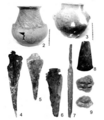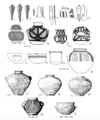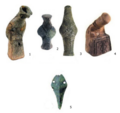 | |
| Geographical range | Northwest Black Sea |
|---|---|
| Period | Copper Age |
| Dates | ca. 3400–2900 BCE |
| Preceded by | Mikhaylovka culture, Kemi-Oba culture, Cucuteni–Trypillia culture, Cernavodă culture |
| Followed by | Yamnaya culture, Ezero culture, Coţofeni culture, Baden culture, possibly Troad, Aegean civilisation (?) |
| Part of a series on |
| Indo-European topics |
|---|
 |

The Usatove culture (Usatove in Ukrainian, Usatovo in Russian) is an Eneolithic group of the North Pontic region with influences from the Cucuteni–Trypillia culture as well as the Eneolithic steppe cultures of the North Pontic. Usatove flourished northwest of the Black Sea during the 4th millennium BCE. The culture got its name from the name of the village of Usatove in the Odesa Oblast of Ukraine.[1]
The Usatove culture appears to be a mixture of the Eneolithic agrarian cultures of Southeast Europe, with influences from the steppe cultures from the Pontic steppe. The Eneolithic farming culture influences on Usatove include clay figurines and painted ceramics, while it shares tumulus (kurgan) burials and shell-tempered coarse wares with steppe cultures. It also displays items made of metal, such as arsenical bronze and silver, which suggests contacts with the North Caucasus as well as Anatolia.
In Ukraine, Usatove culture sites are predominantly located in the Dniester-Danube interfluve. The two largest Usatove archaeological sites in Ukraine, Usatove-Velykyj Kuyalnik and Mayaky, contain kurgan and ground cemeteries (necropoli). The total number of Usatove sites in northwest and west Pontic is currently estimated at around 100.[2]
Within the Kurgan hypothesis, the Usatove culture represents the domination of native Cucuteni–Trypillia agriculturalists by Indo-European peoples from the steppe. According to Anthony, the roots of the pre-Germanic languages lay in the Usatove culture.[3]
While the generally accepted chronological placement of Usatove is in the second half of the 4th millennium BCE, radiocarbon dates on human remains identified as Usatove are consistently older. Most of these dates cluster around the last quarter of the 5th - first quarter of the 4th millennium BCE.[4][5] It is likely that the dates on human remains are influenced by aquatic reservoir effect, the precise quantification of which is not possible at the moment due the lack of radiocarbon and stable isotope data from contextual faunal remains.
Chronology
Radiocarbon dates on pottery are between 3400 and 2900 BCE, around 600 years later than analyses in human bones, which indicate Usatove culture would have lasted (c. 4000-3500 BCE).[6]
Gallery
-
Metal, bone and ceramic artefacts
-
Arsenical bronze swords and copper axe, Ukraine[7]
-
Ceramic and metal artefacts
-
Ceramic vessels, metal tools and burial
-
Metal, bone and ceramic artefacts
-
Ceramic figurines and metal dagger
-
Burial mounds with stone constructions
-
Nevsha stele, c. 3000 BC
-
Stele, 3500-3000 BC
See also
References
- ^ "Entry Display Web Page".
- ^ Dergachev, V. A. (2021). Late Tripolye and Maykop. Rzeszów: Wydawnictwo Uniwersytetu Rzeszowskiego.
- ^ Anthony 2007, p. 359-360.
- ^ Mattila, Tiina; Svensson, Emma; Juras, Anna; Günther, Torsten; Kashuba, Natalija; Ala-Hulkko, Terhi; Chyleński, Maciej; Pospieszny, Łukasz; Constantinescu, Mihai; Rotea, Mihai; Palincaș, Nona; Wilk, Stanisław; Czerniak, Lech; Kruk, Janusz; Łapo, Jerzy; Makarowicz, Przemysław; Potekhina, Inna; Soficaruc, Andrei; Szmyt, Marzena; Szostek, Krzysztof; Götherström, Anders; Storå, Jan; Netea, Mihai; Nikitin, Alexey; Persson, Per; Malmström, Helena; Jakobsson, Mattias (2022-09-12). "Genetic continuity, isolation, and gene flow in Stone Age Central and Eastern Europe". www.researchsquare.com. doi:10.21203/rs.3.rs-1966812/v1. Retrieved 2023-01-29.
- ^ Nikitin, Alexey G.; Ivanova, Svetlana; Budd, Chelsea E.; Culleton, Brendan J.; Potekhina, Inna; Lillie, Malcolm C.; Reich, David (2022-10-03). "Radiocarbon Dating and Stable Isotope Analysis of Human Remains from the Usatovo Culture Site of Mayaki in Ukraine". Rochester, NY. doi:10.2139/ssrn.4236123. SSRN 4236123.
{{cite journal}}: Cite journal requires|journal=(help) - ^ Nikitin, Alexei, (2023). "Interpreting genetic ancestry of the builders of first kurgans", min. 21:50 to 24:30, ARWA Association, 14 May 2023.
- ^ Hansen, Svend (2017). "Arsenic Bronze. An archaeological introduction into a key innovation". Eurasia Antiqua. 23.
Sources
- Манзура, Игорь; Петренко, Владислав. (2022) УСАТОВСКИЙ КУРГАННЫЙ МОГИЛЬНИК II (по раскопкам 1984 г.). Tyragetia, s.n., vol. XVI [XXXI], nr. 1, 2022, 83-101.
- Патокова, Э.Ф. (1979) Усатовское поселение и могильники. Киев: Наукова Думка.
- Петренко, В.Г.; Кайзер, Э. (2011). Комплексный памятник Маяки: новые изотопные даты и некоторые вопросы хронологии наличных культур. Материалы по археологии Северного Причерноморья 12, 31-61.
- Mallory, J. P.; Adams, Douglas Q. (1997). "Ustatovo culture". Encyclopedia of Indo-European Culture. Taylor & Francis. p. 614. ISBN 1884964982.
- Anthony, David W. (2007). The Horse, the Wheel, and Language: How Bronze-Age Riders from the Eurasian Steppes Shaped the Modern World. Princeton University Press. ISBN 978-0-691-14818-2.


![Arsenical bronze swords and copper axe, Ukraine[7]](http://upload.wikimedia.org/wikipedia/commons/thumb/e/e7/Hoard_with_copper_axe_and_five_swords_or_long_daggers_from_Ivan%27ky%2C_Mankivka_District%2C_Ukraine.png/93px-Hoard_with_copper_axe_and_five_swords_or_long_daggers_from_Ivan%27ky%2C_Mankivka_District%2C_Ukraine.png)






